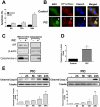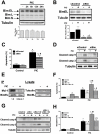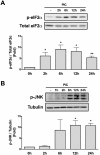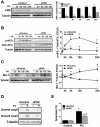Exposure to the viral by-product dsRNA or Coxsackievirus B5 triggers pancreatic beta cell apoptosis via a Bim / Mcl-1 imbalance
- PMID: 21977009
- PMCID: PMC3178579
- DOI: 10.1371/journal.ppat.1002267
Exposure to the viral by-product dsRNA or Coxsackievirus B5 triggers pancreatic beta cell apoptosis via a Bim / Mcl-1 imbalance
Abstract
The rise in type 1 diabetes (T1D) incidence in recent decades is probably related to modifications in environmental factors. Viruses are among the putative environmental triggers of T1D. The mechanisms regulating beta cell responses to viruses, however, remain to be defined. We have presently clarified the signaling pathways leading to beta cell apoptosis following exposure to the viral mimetic double-stranded RNA (dsRNA) and a diabetogenic enterovirus (Coxsackievirus B5). Internal dsRNA induces cell death via the intrinsic mitochondrial pathway. In this process, activation of the dsRNA-dependent protein kinase (PKR) promotes eIF2α phosphorylation and protein synthesis inhibition, leading to downregulation of the antiapoptotic Bcl-2 protein myeloid cell leukemia sequence 1 (Mcl-1). Mcl-1 decrease results in the release of the BH3-only protein Bim, which activates the mitochondrial pathway of apoptosis. Indeed, Bim knockdown prevented both dsRNA- and Coxsackievirus B5-induced beta cell death, and counteracted the proapoptotic effects of Mcl-1 silencing. These observations indicate that the balance between Mcl-1 and Bim is a key factor regulating beta cell survival during diabetogenic viral infections.
Conflict of interest statement
The authors have declared that no competing interests exist.
Figures







Similar articles
-
Endoplasmic reticulum stress sensitizes pancreatic beta cells to interleukin-1β-induced apoptosis via Bim/A1 imbalance.Cell Death Dis. 2013 Jul 4;4(7):e701. doi: 10.1038/cddis.2013.236. Cell Death Dis. 2013. PMID: 23828564 Free PMC article.
-
PTPN2, a candidate gene for type 1 diabetes, modulates pancreatic β-cell apoptosis via regulation of the BH3-only protein Bim.Diabetes. 2011 Dec;60(12):3279-88. doi: 10.2337/db11-0758. Epub 2011 Oct 7. Diabetes. 2011. PMID: 21984578 Free PMC article.
-
Dual inhibition of Bcl-2 and Bcl-xL strikingly enhances PI3K inhibition-induced apoptosis in human myeloid leukemia cells through a GSK3- and Bim-dependent mechanism.Cancer Res. 2013 Feb 15;73(4):1340-51. doi: 10.1158/0008-5472.CAN-12-1365. Epub 2012 Dec 12. Cancer Res. 2013. PMID: 23243017 Free PMC article.
-
Type I interferons as key players in pancreatic β-cell dysfunction in type 1 diabetes.Int Rev Cell Mol Biol. 2021;359:1-80. doi: 10.1016/bs.ircmb.2021.02.011. Epub 2021 Mar 23. Int Rev Cell Mol Biol. 2021. PMID: 33832648 Review.
-
Possible etiological role of impaired endogenous double strand RNA editing in β-cells in type 1 diabetes.J Diabetes Investig. 2024 Sep;15(9):1171-1173. doi: 10.1111/jdi.14224. Epub 2024 Apr 25. J Diabetes Investig. 2024. PMID: 38661313 Free PMC article. Review.
Cited by
-
Nova1 is a master regulator of alternative splicing in pancreatic beta cells.Nucleic Acids Res. 2014 Oct;42(18):11818-30. doi: 10.1093/nar/gku861. Epub 2014 Sep 23. Nucleic Acids Res. 2014. PMID: 25249621 Free PMC article.
-
Enterovirus infection of human islets of Langerhans affects β-cell function resulting in disintegrated islets, decreased glucose stimulated insulin secretion and loss of Golgi structure.BMJ Open Diabetes Res Care. 2016 Aug 10;4(1):e000179. doi: 10.1136/bmjdrc-2015-000179. eCollection 2016. BMJ Open Diabetes Res Care. 2016. PMID: 27547409 Free PMC article.
-
In type 1 diabetes a subset of anti-coxsackievirus B4 antibodies recognize autoantigens and induce apoptosis of pancreatic beta cells.PLoS One. 2013;8(2):e57729. doi: 10.1371/journal.pone.0057729. Epub 2013 Feb 28. PLoS One. 2013. PMID: 23469060 Free PMC article.
-
A neonatal mouse model of central nervous system infections caused by Coxsackievirus B5.Emerg Microbes Infect. 2018 Nov 21;7(1):185. doi: 10.1038/s41426-018-0186-y. Emerg Microbes Infect. 2018. PMID: 30459302 Free PMC article.
-
Seasonality and geography of diabetes mellitus in United States of America dogs.PLoS One. 2022 Aug 5;17(8):e0272297. doi: 10.1371/journal.pone.0272297. eCollection 2022. PLoS One. 2022. PMID: 35930583 Free PMC article.
References
-
- Eizirik DL, Colli ML, Ortis F. The role of inflammation in insulitis and beta cell loss in type 1 diabetes. Nat Rev Endocrinol. 2009;5:219–226. - PubMed
-
- Concannon P, Rich SS, Nepom GT. Genetics of type 1A diabetes. N Engl J Med. 2009;360:1646–1654. - PubMed
-
- Patterson CC, Dahlquist GG, Gyurus E, Green A, Soltesz G. Incidence trends for childhood type 1 diabetes in Europe during 1989-2003 and predicted new cases 2005-20: a multicentre prospective registration study. Lancet. 2009;373:2027–2033. - PubMed
Publication types
MeSH terms
Substances
LinkOut - more resources
Full Text Sources
Other Literature Sources

